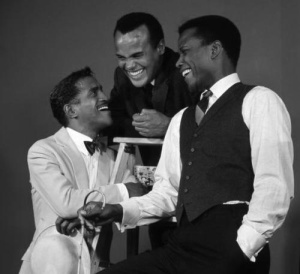My mother adored Harry Belafonte and Sammy Davis Jr. Pre-smarmy suck-up Sammy, although perhaps there never was such a thing. Later, in the 70’s, my parents bought season tickets to the Washington Bullets, our immensely talented basketball team. “It’s almost like ballet!” my ordinarily stoic mother gushed. My parents weren’t into sports; my mother had never even sat down next to my father for the dreary Sunday televised game of football he committed to. My mother craved something that as a young woman had probably been a little dangerous, daring, some kind of unwhite, anti-Schenectady, magical sexy land of crooners and coconuts.
As early as four I understood that my parents, my mother in particular, would love me deeply, tacitly but detectably, for interacting with non-white people. In the Fairfax Safeway I would find another child and befriend him. I would bully children into playing with me. I could see the skepticism on their faces as I went through my flirtations: “You hide and I’ll count,” enacting the kind of colonialism I would later be horrified by. I imagined the warm love rays molded about my mother’s face beaming onto me as I introduced her to my new “friend.” My own school was resolutely white; despite its proximity to Washington, it rarely attracted African Americans unless they were the  son or daughter of an embassy man, and I longed for diversity before I ever knew what it was.
son or daughter of an embassy man, and I longed for diversity before I ever knew what it was.
In the 60’s my parents had marched with Dr.
King, eschewing most protests because they turned violent but showing up for those whose centrifugal force was pacifism. They took my younger brother and I to the city from our McLean outpost–a Virginia so old and so unsullied by carpet-baggery as to be nearly rural, even in its suburbs–where we were treated to restaurants, the Smithsonian, amusement parks, and family walks along the Potomac. My Cloverlawn Academy peers were horrified. Of the amusement park I practically lived for, my friends would cry, “my mother says that’s for Black People!” It was a statement, much like “my mother says we should wear Heavy Coats,” that made no sense to me. My elementary school peers spoke with a kind of respectful terror about “riots” and “fire.” I had no idea what they were talking about. D.C., to me, was a kind of wonderland. It was a restaurant with a miniature railroad on the ceiling, a giant, glass-encased beehive, a merry-go-round, cave-men, sculpture, fireworks, and exciting hippies. I had never seen riots or race-war, only families in line for the Crazy Dazy, or young men with enormous hair louche around Georgetown.
—
I imagine Yvonne Marie Capobianco, my mother, and her best friend Patricia, dragging their bare toes around the dirt beneath the clothes line. They are wearing rolled-up dungarees, a denim unicorn that no longer exists but in some Baudrillardian iteration, a simulacra. They are wearing their fathers’ oversized button-downs, which smell of cotton dried in the sun and ironing. They don sunglasses and drag their toes to “Matilda” which they are humming between giggles and sly looks towards the Capo’s house. What extra frisson is theirs from this calypso? Is it illegal in their homes to listen to a black man sing? Or is the Caribbean gentleman just another New York experience, along with the Irish (Yvonne’s mother) and the Italian (her father, Mario), or her dust-bowl looking grandparents, the Stalters, who lived in the Catskills in 1953? Was this, for Yvonne, like my own moment, when at 12 or 13 I caught Al Green in a white three-piece with a black shirt, singing “Let’s Stay Together” on Midnight Special? It was something like a sexual awakening, how smooth, how adult Al Green was. I remain easily hypnotized by the suavity of a black man, even as I see the construction of it, even though now I recognize that warm scalp tingle from flattery as my brain sending me a flare: Con! Con!
Leave a comment